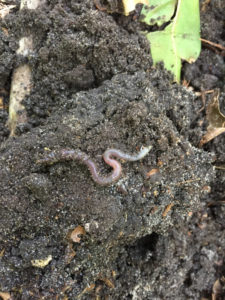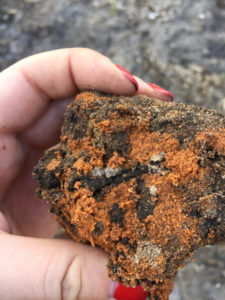Healthy Soils Support Life
By Guest Blogger Mary Tiedeman,
Listen to her podcast episode HERE
As Urban Farm U patrons, we can all attest that healthy soils are better than their unhealthy counterparts, right? But what is the definition of “soil health”? According to the Natural Resource Conservation Service, soil health (or quality) refers to its’ ability to sustain life while functioning as a vital living ecosystem. In other words, good soils support life while serving as their own unique environments!
Sustaining life is a difficult job.
Anyone with experience producing food knows this firsthand. Organisms that interact with soils directly, such as plants, animals, bacteria, and fungi (to name a few) all require a list of amenities in order to survive and thrive. In many ways, the things that soil-dwelling organisms require for life are not much different than those for people. Protection, temperature control, clean air and water, food, and waste management are all essential.
Just like well-built houses, good soils provide a suite of comforts for their inhabitants. They are stable, have a built-in thermostat, contain clean air and water, and a pantry stocked full of food. They even have their own reliable sewage systems and garbage removal services. In order to serve their tenants, soils must possess a few key features including good structure (the way particles clump together), organic matter, and biological activity.
The foundation of a well-functioning soil is its structure.

Granular aggregates seen in a healthy soil settle together loosely, which allows roots, water, air, and organisms to move around easily.
Topsoils with the greatest productivity often have a granular structure, meaning they look like cookie crumbles. These relatively small rounded clumps settle together loosely, creating pores, or pockets of space within the soil. Soil pores come in all shapes and sizes, and each plays a role within soil ecosystems. Large pores work as major highways by carrying excess water away from the root zone. They also facilitate proper ventilation.
This ensures that life-supporting oxygen makes its way to roots and soil organisms while carbon dioxide and other waste products move out of the system. Smaller pores, on the other hand, operate as water storage containers.
Organic matter, another necessary component of healthy soils, works as a glue that binds mineral particles together. It promotes the formation of granules and prevents aggregates from falling apart easily when disturbed by rain and wind. Organic matter is also a good insulator, and so prevents soil systems from getting too hot or cold. If not for this feature, soil would be too hostile of an environment for most living things. Organic matter also is a food and nutrient source for many living things. By offering these services to the system, organic matter encourages life to inhabit the soil.
The final component of healthy soil is biological activity.
In this way, life begets life. All soil creatures, from the tallest tree to the smallest microbe, contribute to the ecological balance of the soil environment. Though each organism plays a specific role, all are a source of organic matter. In death, plants and animals return to the soil to replenish nutrients that they’d previously taken up. In life, they pump countless compounds into the ecosystem. The presence of these compounds, as well as the physical movement of plant roots and animals, help form the cookie crumble structure that is so important for soil quality.

Mosses and shelf fungi decomposing a fallen tree. These organisms assist in returning nutrients and organic materials to the soil.
Soil organisms also serve as nutrient cyclers within a complex food web. Photosynthesizers, like plants and algae, convert carbon from the atmosphere into organic tissue. Decomposers (fungi, fly larvae, ants, bacteria, etc.) on the other hand, release nutrients from dead or dying things – making them available to a suite of other creatures. Microbes in particular contribute greatly to nutrient cycling processes. Some do this by converting nitrogen from the air into plant-available forms while others release phosphorus from minerals and deliver them to plant roots. Many other elements essential to life, such as iron, sulfur, and potassium change forms at the hands of soil organisms.
The size and variety of life forms that influence soil resources are vast, and in many cases, is still being discovered. In fact, scientists estimate that only 5% of soil-dwelling organisms have been identified thus far! What is known is that nearly all soil organisms play a unique role in promoting soil health. In other words, fear not the presence of the various critters living in your soils unless they are doing direct harm to you or your garden!
-

- This earthworm is one of the many creatures that assist in soil development. They move leaves and other organic materials into the soil, and facilitate the formation of granular soil structure
-

- Channels within this clod of red sand show us that worms have been here. All dark spots within the clod are worm casts (feces) containing high amounts of organic matter.
Soils are the foundation for nearly all terrestrial ecosystems, from rainforests to deserts and everything in between. Even aquatic environments depend on healthy soils, as they purify water that flows from land into surface water and groundwater systems. Like human health, soil health is not static. If we are not careful, mismanagement can reduce soil’s capacity to support life. For farmers, this could mean lost productivity or crop failure in the face of natural disasters. The good news though is that by promoting soil quality, we can insure the health of humans and our planet’s ecosystems for generations to come.
Editor’s Note: Check out Podcast 317: Mary Tiedman on Soil Formation.
 Guest Bio: Mary is a soil scientist and Agro-ecology PhD student at Florida International University in Miami. Originally from Iowa, she received her B.S. and M.S. degrees in Environmental Science and Agronomy at Iowa State University. Her master’s research was on ants and the ways they influence prairie soil formation. Her passion for soils has taken her across the globe, from the Alaskan Arctic to, tropical rain forests – and many places in between – all in hopes to better understand soil functioning in different ecosystems. When not chipping away at her dissertation, Mary is a volunteer blogger for Soils Matter, a blog run by the Soil Science Society of America which is working to share soils information with broad audiences.
Guest Bio: Mary is a soil scientist and Agro-ecology PhD student at Florida International University in Miami. Originally from Iowa, she received her B.S. and M.S. degrees in Environmental Science and Agronomy at Iowa State University. Her master’s research was on ants and the ways they influence prairie soil formation. Her passion for soils has taken her across the globe, from the Alaskan Arctic to, tropical rain forests – and many places in between – all in hopes to better understand soil functioning in different ecosystems. When not chipping away at her dissertation, Mary is a volunteer blogger for Soils Matter, a blog run by the Soil Science Society of America which is working to share soils information with broad audiences.
Mary Tiedeman
PhD Student, Soil Microbiology
SaveSaveSaveSave
*Disclosure:
Some of the links in our podcast show notes and blog posts are affiliate links and if you go through them to make a purchase, we will earn a nominal commission at no cost to you. We offer links to items recommended by our podcast guests and guest writers as a service to our audience and these items are not selected because of the commission we receive from your purchases. We know the decision is yours, and whether you decide to buy something is completely up to you.









How do all the little beasties in my above-ground containers handle the deep freezes of winter in Montana? Should I be providing some kind of protection or will the soil health maintain itself from one season to the next?
Hi Dawn,
Thanks for the great question! Soil organisms are pretty resilient, but there are a few ways that you can manage your soils for winter. The #1 rule of thumb is to keep your soils covered, either with mulch, leaf litter, or snow. I’ve actually written about soils in winter a few times for Soils Matter, a blog run by the Soil Science Society of America. “Soils in Winter” can be found here: https://soilsmatter.wordpress.com/2016/01/14/what-happens-to-soil-in-winter-does-everything-die/
Information on “Snow and Soil” can be found here: https://soilsmatter.wordpress.com/2017/02/15/why-is-it-good-to-have-the-ground-covered-by-snow/